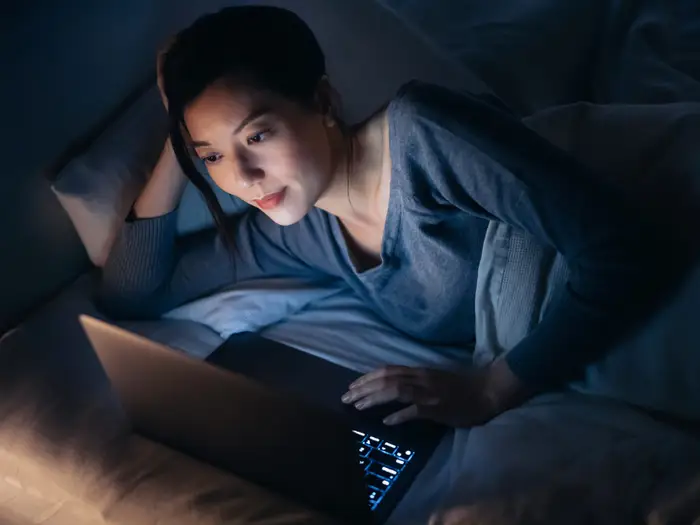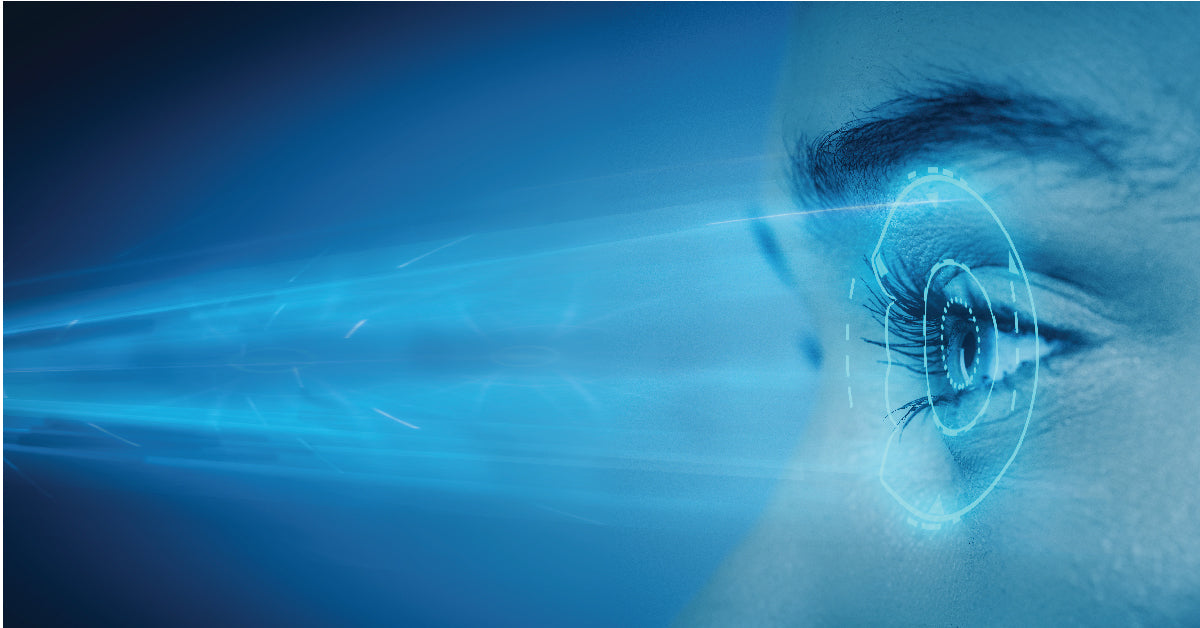
Blue Light and Skin Aging: How Screens Are Speeding Up Fine Lines and Pigmentation

Blue Light and Skin Aging: How Screens Are Speeding Up Fine Lines and Pigmentation
In a world where our lives revolve around screens, from early morning emails to late-night scrolling, blue light exposure has become unavoidable. While it’s well-known that the sun’s UV rays can cause premature aging and pigmentation, few realize that the blue light emitted from our digital devices may be just as harmful over time.
Whether you’re working long hours in front of a laptop or glued to your phone, your skin is constantly battling the invisible effects of screen radiation. This article explores how blue light accelerates aging, what it does to your skin barrier, and how to protect and repair your skin from its daily impact.

Understanding Blue Light and Its Source
Blue light, also known as high-energy visible (HEV) light, is a part of the visible light spectrum emitted not only by the sun but also by electronic devices such as laptops, tablets, mobile phones, and LED screens.
Unlike UV rays, which are mostly filtered out by window glass, blue light penetrates deeper into the skin, reaching the dermis, where collagen, elastin, and skin cells live. This deep penetration is what makes it particularly damaging over time.
While blue light from screens is much weaker than UV rays from sunlight, the cumulative exposure, often 8–10 hours per day, creates a consistent oxidative stress on the skin, leading to premature aging, pigmentation, and inflammation.

How Blue Light Damages the Skin
1. Accelerated Collagen Breakdown
Blue light generates reactive oxygen species (ROS), unstable molecules that cause oxidative stress in skin cells. This oxidative stress damages collagen and elastin, the proteins responsible for keeping your skin firm and smooth. Over time, this leads to fine lines, sagging skin, and loss of elasticity.
The damage occurs silently, even if you don’t see immediate signs. You may notice your skin looking tired, less radiant, or older than before despite minimal sun exposure.
2. Hyperpigmentation and Uneven Skin Tone
Blue light triggers melanogenesis, the process by which skin cells produce melanin (the pigment that gives skin its color). This means long hours in front of screens can cause dark spots, uneven tone, and pigmentation patches, especially in people with medium to darker skin tones.
This effect is often worse for those already struggling with post-inflammatory marks from acne or hormonal pigmentation, as blue light can deepen those spots over time.
3. Skin Barrier Disruption
Constant exposure to blue light weakens the lipid barrier, the protective layer that keeps moisture in and pollutants out. A compromised barrier makes skin more prone to dryness, redness, and sensitivity.
If you’ve noticed your skin feeling tight, flaky, or dull after long workdays, your screen could be partially to blame.
4. Inflammation and Sensitivity
Blue light exposure also increases inflammatory cytokines in the skin, which can trigger conditions like rosacea, eczema flare-ups, or adult acne.
For many office-goers, skin irritation is often mistaken for product reaction, when in fact, it’s caused by digital inflammation.

Blue Light and Gender: How It Affects Men and Women Differently
For Women:
Women’s skin is often more sensitive to hormonal fluctuations, which can amplify the effects of blue light. Combined with hormonal pigmentation (melasma or dark patches), screen exposure can worsen uneven skin tone and hyperpigmentation. Women who use makeup daily may also experience more oxidative stress if their products contain photosensitive ingredients that react to light.
For Men:
Men, on the other hand, often overlook skincare and sun protection, assuming indoor environments are safe. Blue light can penetrate through facial hair and affect deeper skin layers, leading to fine lines and early aging around the eyes and forehead. In addition, frequent shaving can make their skin barrier more vulnerable to oxidative stress.
The Role of Lifestyle: How Desk Jobs Make It Worse

Desk workers are among the most affected because their exposure to blue light is constant and prolonged.
Between laptops, phones, and artificial LED lighting, your skin rarely gets a break. Combine that with stress, dehydration, lack of sleep, and poor diet, and you’ve got the perfect recipe for premature aging.
Sedentary habits also reduce blood circulation, which means your skin receives less oxygen and nutrients, further dulling your complexion and slowing its ability to repair damage.
How to Protect Your Skin from Blue Light Damage
The good news is that you don’t have to give up technology to protect your skin. With smart skincare, dietary adjustments, and healthy habits, you can minimize blue light damage and maintain youthful, glowing skin even with a desk job.
1. Apply Antioxidant-Rich Skincare
Antioxidants neutralize free radicals and strengthen the skin barrier. Look for ingredients like:
- Vitamin C – brightens and protects against oxidative damage
- Niacinamide – strengthens barrier and reduces pigmentation
- Resveratrol – provides long-lasting antioxidant protection
- Green tea extract – calms inflammation
- Lycopene and Coenzyme Q10 – repair oxidative stress
Using these in your morning routine under SPF creates a daily “shield” against digital damage.
2. Never Skip Sunscreen, Even Indoors
Blue light can pass through windows and indoor light sources.
Use a broad-spectrum sunscreen with iron oxides, which specifically protect against visible and blue light. Reapply every 3–4 hours if you sit near windows or use multiple screens daily.
3. Strengthen Your Diet with Skin-Repair Nutrients
Your skin’s resilience depends on what you eat. A blue light defense diet should include:
- Vitamin C and E (citrus fruits, almonds, spinach)
- Omega-3 fatty acids (flaxseeds, walnuts, fish)
- Beta-carotene and lycopene (tomatoes, carrots)
- Polyphenols and flavonoids (berries, green tea, dark chocolate)
These nutrients act as internal antioxidants, protecting skin cells from daily screen-induced stress.
4. Consider Functional Supplements
For professionals who spend 8–10 hours in front of screens, certain supplements can be game-changers:
- Astaxanthin – a powerful antioxidant known for protecting skin against blue light–induced damage
- Lutein and Zeaxanthin – protect eyes and skin from digital light
- Collagen peptides – repair structural proteins damaged by oxidative stress
- Vitamin D3 – counteracts the deficiency caused by limited sunlight exposure
Always consult a qualified wellness practitioner before starting any supplements to ensure the right dosage and combination for your body.
5. Take Screen Breaks and Practice the 20–20–20 Rule
Every 20 minutes, look 20 feet away for 20 seconds to rest your eyes and allow your facial muscles to relax. This not only reduces digital fatigue but also prevents repetitive muscle strain that leads to wrinkles.
6. Adjust Your Workstation Lighting
- Use anti-glare screens or blue-light filters on devices.
- Reduce screen brightness to 50–60%.
- Switch to warm lighting in your workspace instead of harsh LED light.
These small adjustments minimize exposure intensity without affecting productivity.
7. Hydrate Consistently
Indoor air-conditioning combined with screen exposure leads to water loss through the skin.
Aim for 2.5–3 liters of water daily and include electrolytes or coconut water to maintain hydration balance. A hydrated skin barrier is naturally more resistant to oxidative stress.
8. Build a Night-Time Recovery Routine
After long hours of exposure, night-time is when your skin goes into repair mode.
Use:
- A gentle cleanser to remove pollutants and sweat
- A restorative serum rich in peptides or ceramides
- A sleeping mask or night cream with antioxidants like Vitamin E, CoQ10, or bakuchiol
This routine supports overnight repair, allowing your skin to recover from digital damage effectively.
Blue Light, Eyes, and Mental Health

It’s not just your skin that’s affected, your eyes and circadian rhythm suffer too.
Blue light exposure in the evening suppresses melatonin, the hormone responsible for sleep. This can cause insomnia, dark circles, and tired-looking skin.
Wearing blue light–blocking glasses and avoiding screens at least one hour before bed can help restore your body’s natural sleep rhythm and indirectly improve your skin’s recovery process.
When to Seek Professional Help
If you notice:
- Persistent pigmentation or uneven skin tone
- Rough texture or loss of elasticity
- Dryness that doesn’t respond to moisturizers
- Early fine lines around eyes and mouth
It’s time to visit a functional skincare clinic like Midas Wellness Hub.
Professional treatments such as HydraFacial, chemical peels, mesotherapy, or collagen-inducing therapies can restore balance and rebuild skin health at the cellular level.
The Bottom Line
Blue light is not just an eye strain issue, it’s a modern skin-aging factor that most people underestimate.
With our lives deeply integrated with technology, protecting your skin from digital damage is no longer optional; it’s essential.
By combining:
- Antioxidant skincare,
- Functional nutrition and supplements, and
- Balanced screen-time habits,
you can maintain youthful, even-toned, and resilient skin, no matter how many hours you spend at your desk.
At Midas Wellness Hub, we believe true skin health begins beneath the surface.
Our approach integrates science-backed skincare with lifestyle and nutrition, ensuring that your skin not only looks radiant but stays that way for years to come.

It’s interesting how blue light, something we associate mostly with eye strain, is now being linked to skin aging as well. I appreciate that this topic brings attention to the less obvious effects of our screen time, especially for people who spend long hours on devices. It makes me think more seriously about how everyday habits—like working on laptops or scrolling before bed—might be quietly impacting skin health over time.
We’re glad you found that insight helpful! Blue light exposure is often overlooked in skincare, but protecting the skin from digital stress is now an essential part of modern wellness.
For more details contact us on 7506019315 or
visit us Shop no 2, Krishna Koyna, Kastur Park Rd, Kastur Park, Borivali West, Mumbai, Maharashtra 400092